The Hmong people, with their unique traditional activities and customs, have created a series of specialty dishes that are indispensable in the highland markets. These dishes not only carry excellent flavors but also reflect the diversity and uniqueness of Hmong culture. Today, let’s join Loka Ha Giang in exploring the most remarkable Hmong traditional foods in the following article.
Here is a brief introduction about the Hmong people
The Hmong people are an ethnic minority with origins in the Southeast Asian region, primarily concentrated in the mountainous provinces of northern Vietnam and neighboring countries such as China, Laos, and Thailand. They possess a unique language, culture, and traditions that contribute significantly to the cultural diversity of this region’s ethnic groups.

With a diverse and rich culture, the Hmong people have preserved and passed down their unique traditions through generations. As one of the notable ethnic minorities in the Southeast Asian region, the Hmong have created a range of distinctive and abundant dishes. With characteristic cuisine, excellent flavors, and unique cooking methods, Hmong traditional food has captured the attention of many and become an integral part of their culinary heritage.
Hmong culinary culture
The culinary culture of the Hmong people reflects a harmonious way of life with nature and a dependence on agriculture and livestock. The Hmong prioritize high nutritional needs and have developed special agricultural and farming methods to meet these needs.
In agriculture, the Hmong often cultivate staple crops such as rice, corn, sugarcane, and various vegetables. They focus on using traditional methods such as field cultivation and terracing systems to maximize land utilization in hilly and mountainous regions. This enables them to harvest a variety of agricultural products and ensure a diverse and abundant food source for their families.
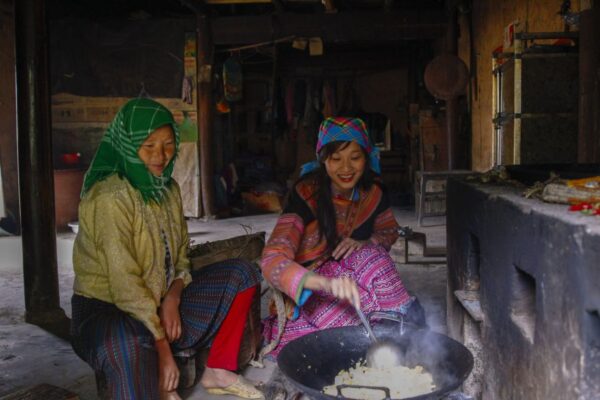
Furthermore, the Hmong exhibit creativity in fishing and hunting wild animals. They employ traditional techniques such as hand fishing, fishing nets, and large traps, or use bows and arrows for hunting in the forest. The success in fishing and hunting provides them with nutrient-rich food sources and creates unique and exciting dishes in Hmong cuisine.
Especially, the Hmong prefer to use natural and fresh ingredients to create their traditional dishes. They utilize various wild vegetables and spices from the surrounding natural environment, such as leaves, herbs, and fruits, to enhance the freshness and uniqueness of their meals. The meticulous and skillful combination of food ingredients and distinctive spices by the Hmong has resulted in a diverse, rich, and unique culinary tradition.
Hmong Traditional Food
Men Men
Men Men is a traditional dish of the Mong people. It is not a sophisticated or fancy dish, but it holds a deep connection in the memories of many people who have tasted it once. This dish is made from local corn kernels, a familiar ingredient in the daily lives of the Mong people. After each harvest season, the corn is stored on verandas or attic kitchens to completely dry before being used to make Men Men. The process of preparing this dish requires skill and time.
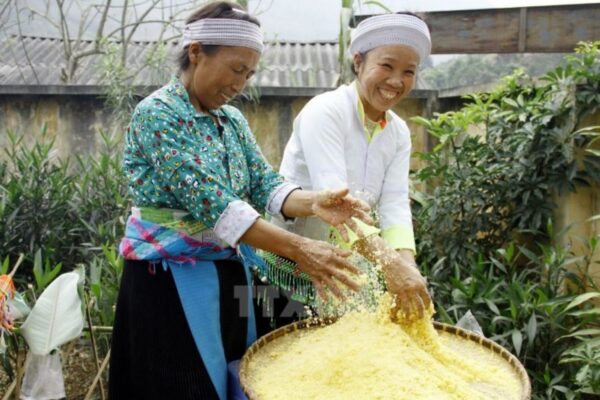
First, the corn kernels are separated and any damaged or moldy ones are discarded, leaving only the roundest and finest kernels. Then, the corn is ground. The Mong people still use traditional stone mortar and pestle for this, which can be considered the most labor-intensive step in the process of making Men Men.
After the corn has been ground, the flour is sifted to remove husks and impurities. Then, the flour is poured into a container and mixed thoroughly with a little water. At this point, the Mong people have to calculate the amount of water to ensure that the flour is neither too dry nor too sticky. If the flour is too dry, it will be difficult to steam, and if it is too sticky, the dish will turn out mushy and unappetizing. That’s why those who make Men Men are usually experienced cooks in the family, to ensure the right consistency and preserve the excellent flavor of the dish.
Unlike many other dishes, Men Men is steamed twice. A large steaming pot is used, filled with water, and a tall steaming tray is placed in the middle of the pot. The flour mixture, after being thoroughly mixed with water, is placed in this tray.
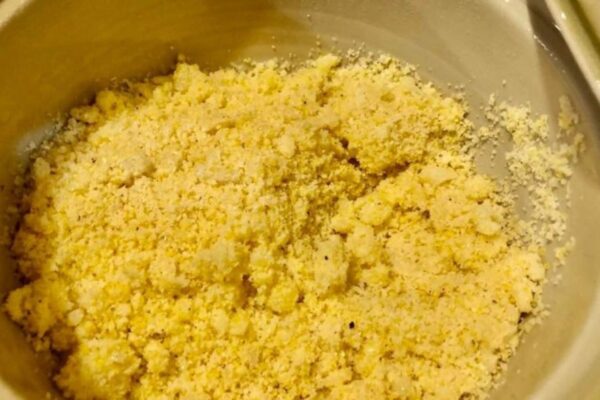
Mixed rice Men Men is a combination that many Mong people enjoy, with the sweet, nutty, and fragrant flavors of corn, along with the soft texture of rice. At local markets, this dish is often served with a broth to accompany pho or noodles. In the past, the Mong people only used to have Men Men within their families, but nowadays, it is made more often to be sold at markets. Therefore, visitors who visit highland markets can also find and buy this rustic and distinctive dish of the Mong people.
Thang Co
Thang Co is a distinctive and traditional dish of the Mong people, popular in the central highlands and northern mountainous regions. This dish originally originated from Yunnan, China, and was later introduced to the Kinh, Dao, and Tay ethnic groups.
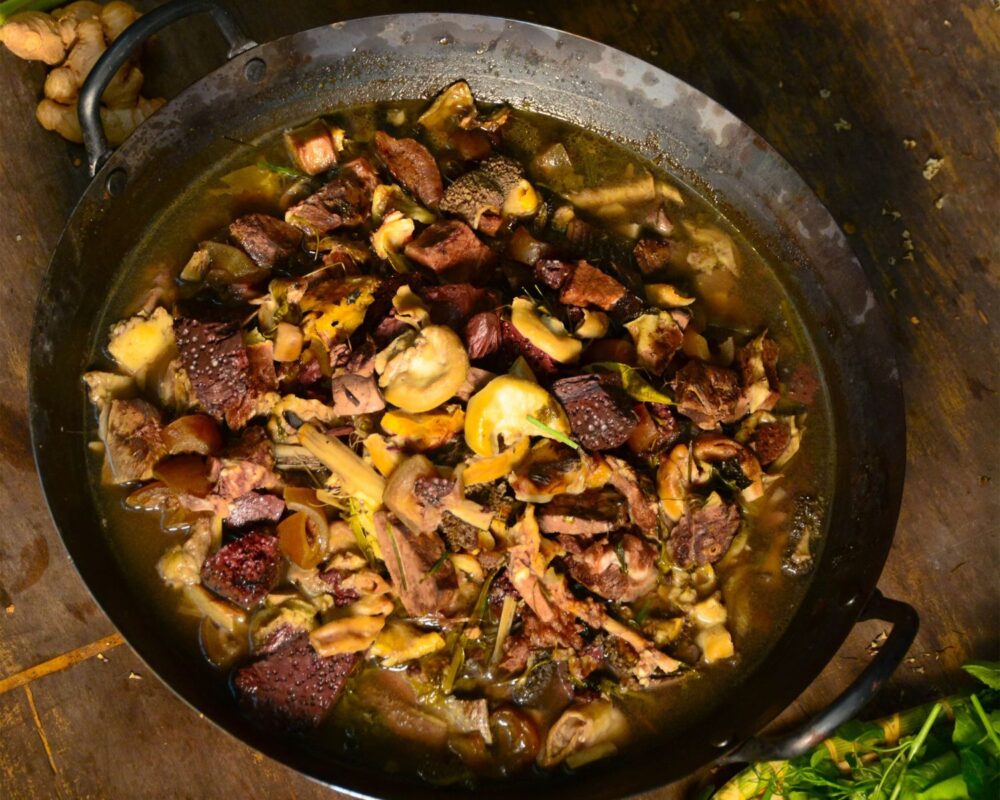
Thang Co is prepared simply, but to cook a delicious dish, it still requires its own secrets and experience. The process begins by slaughtering a horse, cow, goat, or pig, then cleaning the meat and cutting it into pieces. All edible parts of the animal, such as the thigh meat, rump meat, heart, liver, intestines, etc., are placed in a large pot (an old pot, not a new one) over a lit charcoal fire. They are stir-fried using the animal’s own fat (using the fat present in the meat for stir-frying, without adding additional fat). When the meat becomes fragrant and enticing in color, water is added to the pot, and the dish continues to simmer vigorously for a long period of time.
To create a delicious broth, Mong chefs must carefully cook the water. They scoop out the scum with a ladle to make the bone broth sweeter and more flavorful. Parts such as heart, liver, spleen, intestines, meat, and bones are added to the broth last and cooked slowly, with the option of adding various vegetables. Traditional spices include salt, Sichuan peppercorns, fennel seeds, cinnamon, and lemongrass leaves that are toasted and ground before being marinated with the meat prior to stir-frying. However, nowadays, the spice ingredients have changed significantly in restaurants and eateries, resulting in noticeable differences in the taste of the dish.
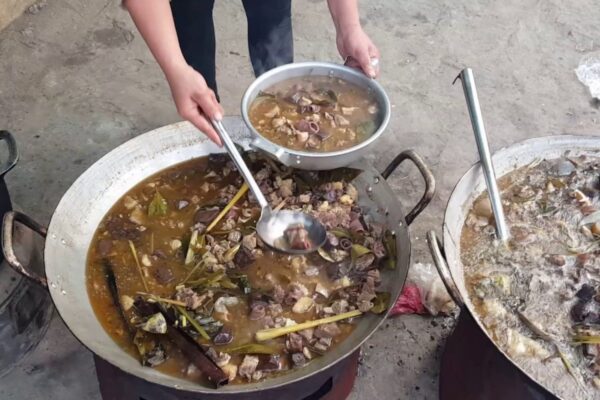
When eating, the pot is kept on the stove, and each person scoops from the pot into their own bowl. Thang Co is often prepared during festivals, forest protection ceremonies, or gatherings with a large number of people such as village fairs, family reunions, or local markets.
Ruou Ngo
Corn wine is a special traditional liquor of the Hmong people, made from whole corn kernels. The process of making this wine goes through several complex stages, from soaking the corn, steaming it, to the fermentation and aging process. Each stage requires patience and skill to produce a high-quality corn wine.
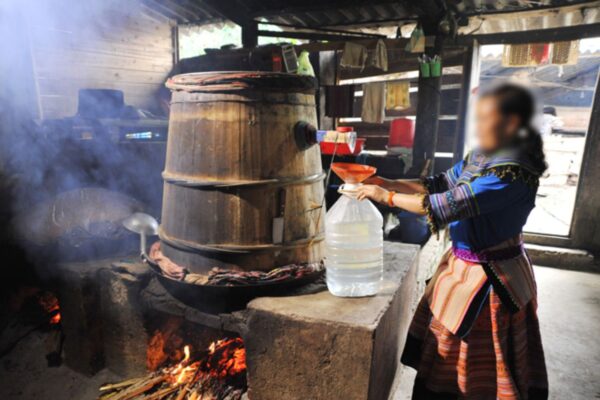
First, the whole corn kernels are prepared and soaked in water for one to two days to allow the corn to swell and soften. Then, the corn is steamed in a steamer to ensure that it is evenly cooked. This process helps preserve the natural flavor and necessary moisture for the fermentation process.
Next, the steamed corn is allowed to cool and then mixed with the starter culture to initiate the fermentation process. During this stage, the starter culture comes into contact with the sugars present in the corn, causing fermentation to occur, where starch is converted into sugar and then into alcohol. The fermentation process takes place in a special wooden barrel and lasts for one to two weeks, depending on environmental factors and temperature.
After the fermentation process is complete, the wine is transferred to other wooden barrels for aging. The aging period also affects the final flavor and color of the corn wine. The wine is typically aged in wooden barrels for one to three months, during which time it continues to mellow and develop rich, flavorful aromas.

Corn wine has a distinctive and robust flavor and is often enjoyed during festivals, within families, and at social gatherings. It not only represents the cultural beauty of the Hmong people but also provides a unique culinary experience and adds warmth to social interactions and sharing.
Ot Nuong
Grilled chili peppers, or “ot nuong,” are an incredibly popular and distinctive dish in Hmong cuisine. This dish is made from carefully selected fresh chili peppers. The cooking process begins by grilling the peppers over charcoal or in a pan, creating a special and enticing flavor.
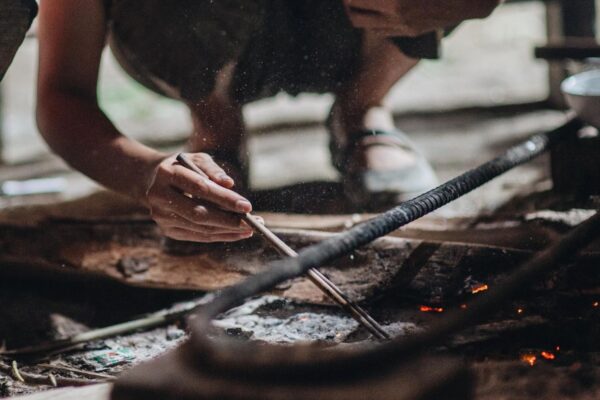
Grilled chili peppers are often enjoyed with grilled meat, spices, and raw vegetables, creating a delicious, flavorful, spicy, and enticing dish. The grilled peppers bring forth an alluring flavor, a harmonious blend of spicy heat and the aroma of charred peppers. When combined with grilled meat, the dish becomes well-balanced, diverse, and exciting.
Grilled chili peppers not only create a robust dish in Hmong cuisine but also showcase the creativity and love of Hmong people for spicy seasonings. The intense spiciness of the grilled peppers provides a unique culinary experience, stimulating the taste buds and bringing satisfaction to those who indulge in it.
Pho Chua Bac Ha
Pho Chua Bac Ha, or Sour Pho of Bac Ha, is a traditional and distinctive dish of the Hmong people, carrying a unique and special flavor. This dish is made from key ingredients including sour pho noodles, pork, spices, and flavorful broth. The process of preparing Pho Chua Bac Ha requires meticulousness and skill to create an enticing dish.

Sour pho noodles are a characteristic type of noodle in Hmong cuisine, with a compact shape and mainly made from rice flour. The noodles are made from rice flour that has been soaked in water and fermented for a certain period of time. This fermentation process creates a light sour taste that is characteristic of sour pho noodles. Then, the sour pho noodles are briefly blanched in boiling water to soften and retain their elasticity.
Pork is the main ingredient in Pho Chua Bac Ha. The pork is carefully selected, thinly sliced, and then cooked with spices such as garlic, onions, pepper, and salt. This process helps the pork become flavorful and tender, creating a distinctive taste for the dish.
The broth is an important element in Pho Chua Bac Ha. The broth is cooked from pork bones, spices, and herbs to create a delicious and rich flavor. The simmering process allows the flavors from the bones and spices to meld together, resulting in a hearty and full-bodied broth.
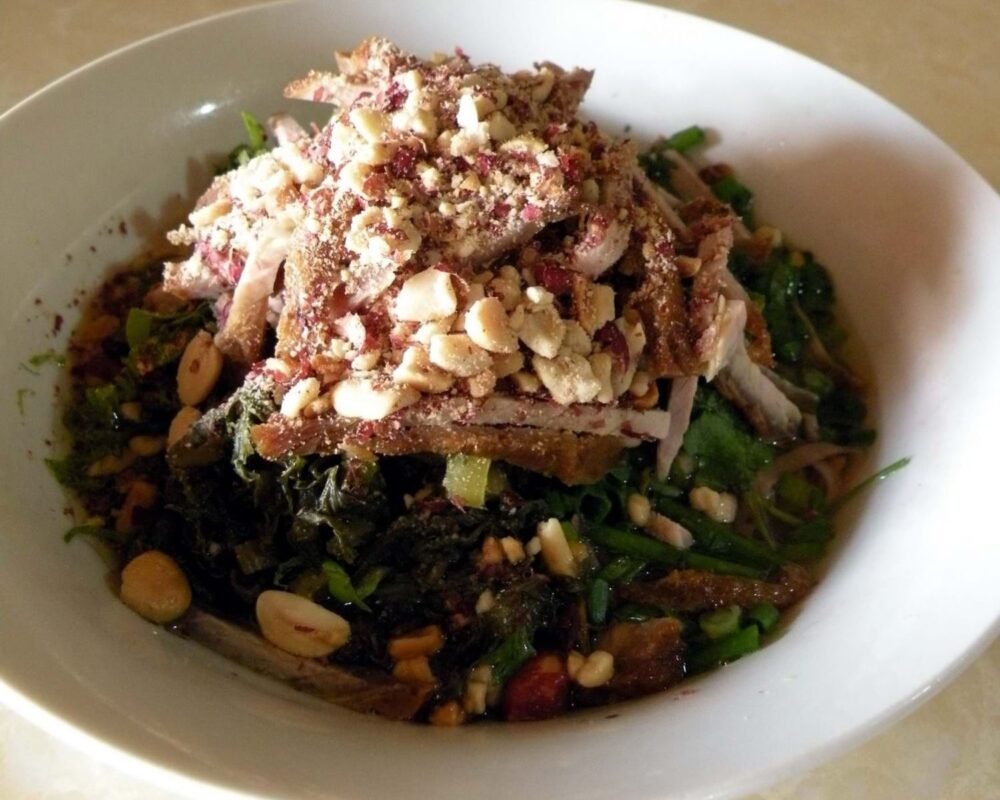
When enjoying Pho Chua Bac Ha, the dish is often accompanied by raw vegetables such as lettuce, fish mint, cilantro, and sweet and sour fish sauce. This combination creates a richness and diversity of flavors, bringing a fresh and balanced sensation to the dish.
Pho Chua Bac Ha is not only a distinctive dish of the Hmong people but also showcases their culinary sophistication and talent. With its unique flavor and delicate combination of ingredients, this dish offers diners a unique and memorable culinary experience.
Banh Ngo
Corn cake, or “banh ngo,” is a special traditional cake of the Hmong people, made from ground corn and other natural ingredients. This cake has a sweet, rich, and distinctly characteristic taste of Hmong culinary culture. The process of making corn cake involves steaming or baking, creating a delicious and enticing treat.
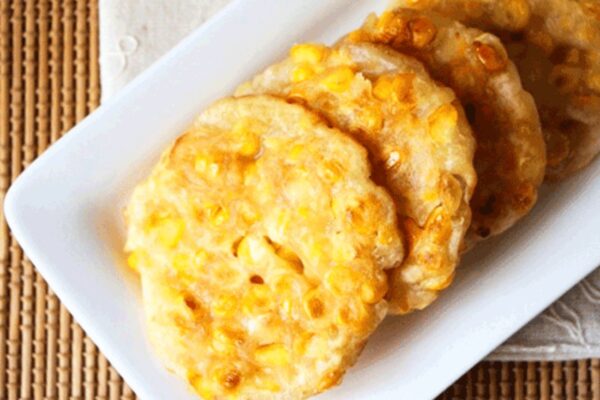
The main ingredient for making corn cake is finely ground corn, carefully selected and milled into a smooth flour. This corn flour is combined with other natural ingredients such as sugar, sesame oil, and a pinch of salt to create a special mixture. These natural ingredients contribute to the natural sweetness and smooth, creamy texture of the corn cake.
Once the mixture is prepared, the next step in cooking corn cake is steaming or baking. When steaming, the corn flour mixture is placed in small trays or bowls, then placed over a steamer to cook evenly. The steaming process helps the corn cake become soft, smooth, and retain the natural sweetness of the corn.
Additionally, corn cake can also be prepared by the method of baking. The corn flour mixture is placed in cake molds and baked over fire or in an oven. The baking process creates a crispy, golden crust on the outside, while the inside of the cake remains soft, smooth, and fragrant.
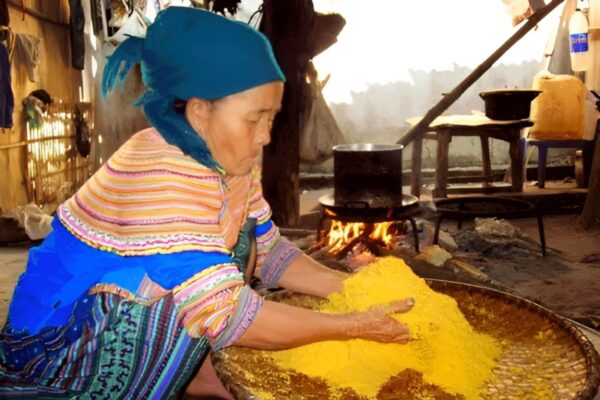
Corn cake is not just an ordinary dish in Hmong cuisine, but it also plays an important role in special occasions such as festivals, weddings, or family celebrations. This cake showcases the meticulousness and sophistication in the cooking process, while delivering a sweet and familiar taste to those who indulge in it. Corn cake becomes a symbol of the distinctive culinary culture of the Hmong people, marking unity and joy in their lives.
Banh Lao Khao
In regions like Sin Lung, Thai Phin Tung, Van Chai, Sung Trai, the Mong people cannot do without banh lao khoai (also known as luc khoai or ro khoai) made from corn flour during the Tet holiday. The tradition of settling in ethnic and clan communities means that every time the Lunar New Year arrives, the Mong people gather to make a large batch of banh lao khoai to eat throughout the first lunar month.
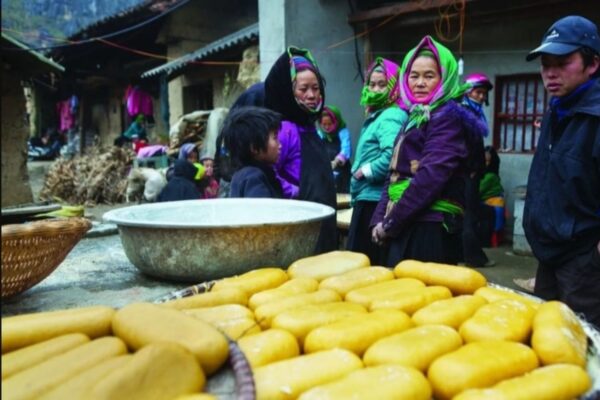
The process of making banh lao khoai starts with using mature corn flour. The corn flour is placed in a stone mortar and pounded until it becomes a smooth and elastic mixture. Then, the corn flour mixture is placed on a stone table and kneaded into oval-shaped cakes with a diameter of about 15-20 cm. Afterward, the cakes are spread with lard and honey on the surface. Banh lao khoai can be stored for a long period of time. When eating, the Mong people can cut the cakes into small pieces and grill them over charcoal until they puff up and release a fragrant aroma.
Banh lao khoai is a traditional cake prepared by the Mong people in the Northwest during festivals, holidays, or for sale at local markets, and it is always well-liked. This dish not only reflects unity and love within the Mong community but also brings a sweet and enticing flavor, an essential part of their traditional meals.
Banh Day
Banh day is a traditional cake and the process of pounding banh day plays an important role in the festivals, celebrations, and Tet of the Mong ethnic community in the northern mountainous region. Banh day is not only a symbol of love and unwavering loyalty between Mong men and women according to ancient beliefs, but it is also considered a symbol of the moon and the sun, the origins of life and all things on Earth. In the Mong language, banh day is also called “Pe-Plau.”
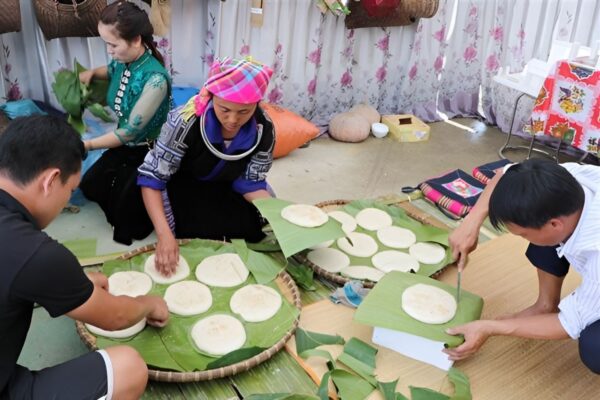
The process of making banh day requires meticulousness and attention to detail. The main ingredient is fragrant sticky rice, steamed until it becomes glutinous rice. Toasted sesame seeds and cooked egg yolks are prepared in advance. When making the cake, the Mong people rub their hands and the utensils with oil to prevent the cake from sticking. Banh day is best enjoyed when it is still hot right after being made. To fully savor the rich and distinct flavor of the local glutinous rice and the unique taste of the highland region, the cake can be fried or grilled. It is even more delightful when paired with sugarcane or honey.
Although banh day exists in many different ethnic groups, its preparation and taste will never be the same as those made by the Mong people. Explaining this is also a challenge. To truly understand, one must visit the Northwest mountains to experience the gifts of nature and witness the delicate process of making banh day by the hospitable Mong people in the land of Fog.
Hmong traditional food is not just about delicious dishes; it is an integral part of the Hmong cultural heritage and culinary legacy. Through their unique and diverse cuisine, the Hmong people convey cultural values and love for their country and family. With the diversity and combination of natural ingredients, Hmong cuisine has made its own mark in the culinary world and has become an indispensable part of the global culinary heritage.

My name is Giap Van Hai, I am a travel enthusiast and always want to share the beauty of Ha Giang with everyone. With a deep love for the mountains and the typical culture of Ha Giang people, I decided to establish Loka Ha Giang – a website specializing in Ha Giang tourism services. We provide travel services such as Ha Giang Loop, Ha Giang Trekking, Ha Giang Easyrider
